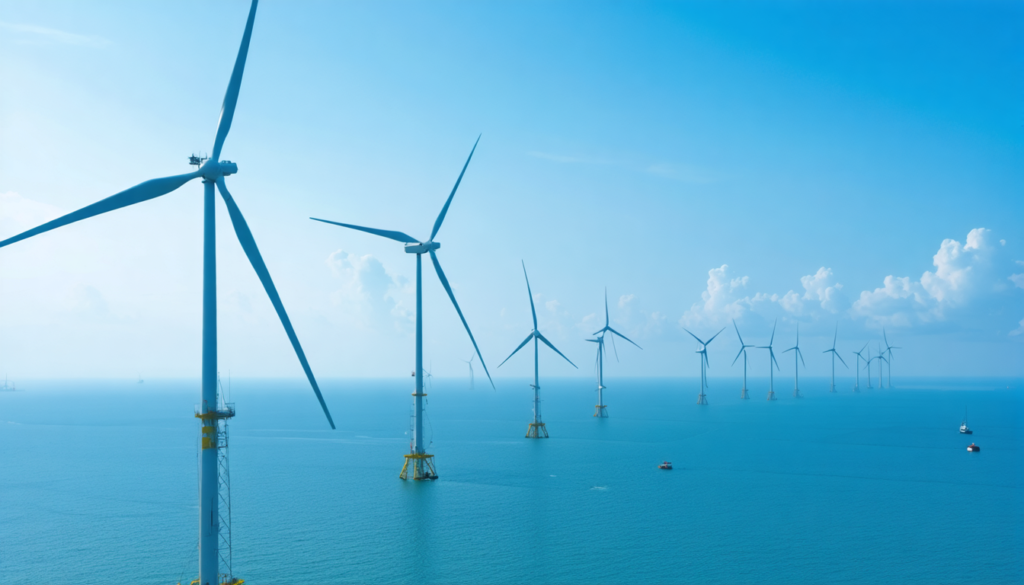The challenge of climate change poses urgent issues for Asia’s rapidly growing economies, as industries struggle to meet rising energy demands without exacerbating environmental degradation. This pressure can lead to economic setbacks, social unrest, and negative impacts on public health. To address these pressing demands, a transformative energy transition is essential, harnessing sustainable practices that foster economic growth and protect the environment.
Asia has positioned itself as a frontrunner in this energy transition, embracing innovative technologies and cooperative strategies to ensure a sustainable future. By developing comprehensive policies, investing in renewable energy resources, and collaborating across borders for integrated solutions, Asian countries, including Thailand, Vietnam, Japan, Singapore, and Indonesia, are setting benchmarks in the shift toward cleaner energy solutions.
Overview: The Energy Landscape in Asia
As the world’s largest continent, Asia is home to numerous countries striving to meet growing energy demands while embarking on ambitious renewable energy strategies. The energy landscape in Asia is increasingly diverse, with nations adopting various technologies and regulatory frameworks to accelerate their transition to sustainable energy sources.
This evolution is driven by several factors:
- Population Growth: The rising number of residents in urban areas generates a surge in energy needs, thereby creating pressure on existing energy systems.
- Economic Development: Rapid industrialization drives energy consumption, necessitating urgent measures to diversify energy supplies.
- Climate Goals: Increasing global awareness regarding climate change encourages many Asian nations to establish ambitious targets for carbon neutrality.
Examining the potent interplay of these factors unveils the scope of opportunities for nations to adopt innovative strategies tailored specifically for their contexts.
Thailand: Pioneering Low-Carbon Initiatives
Thailand has emerged as a regional leader in low-carbon innovation, instituting various initiatives to achieve carbon neutrality by 2050 and net-zero greenhouse gas emissions by 2065. These initiatives reflect the nation’s commitment towards building a sustainable future, setting the stage for transformative change.
Draft Climate Change Act
Scheduled for submission to cabinet approval by January 2025, the Draft Climate Change Act (Draft CCA) aims to create robust frameworks for monitoring and managing greenhouse gas emissions. It introduces comprehensive measures for carbon pricing and the establishment of significant funding mechanisms to support emission reduction initiatives, opening avenues for green finance growth.
Carbon Capture and Storage (CCS)
Thailand is also focusing on Carbon Capture and Storage (CCS) technologies through projects such as the Arthit CCS Hub, representing a leap toward realizing its CCS and CCUS potential. By establishing legal frameworks that oversee CCS operations, the nation encourages investments to drive innovation in this sphere.
Renewable Energy Expansion
With the introduction of Utility Green Tariffs and groundbreaking Direct Power Purchase Agreements (PPAs), Thailand is facilitating the integration of solar and renewable energy sources into its energy supply portfolio. As part of a significant shift, the region aims to progressively reduce reliance on fossil fuels.
Vietnam: Offshore Wind Leadership and Regulatory Overhaul
Vietnam stands at the forefront of offshore wind developments and regulatory advancements, reinforcing its commitment to enhancing the energy landscape through newfound legislative measures. The recent enactment of the Law on Electricity 2024 heralds a transformative change across the sector.
Law on Electricity 2024
This groundbreaking law broadens the definition of renewable energy, paving the way for the integration of green hydrogen, energy storage systems, and offshore wind projects into the national grid. Priority is given to large-scale initiatives aimed at establishing renewable energy clusters, thereby enhancing Vietnam’s electricity infrastructure.
Regulatory Reforms
The expiration of previous feed-in tariff mechanisms spurred significant legislative changes, designed to address existing challenges and instill confidence among investors. Amendments introduced by the Ministry of Industry and Trade (MOIT) promote clearer project implementation guidelines, ultimately reducing barriers hindering development.
Environmental Impact and Future Outlook
By fortifying its regulatory framework, Vietnam not only strengthens its energy transition but also heightens the appeal of its renewable energy market for long-term investments. The measures in place encompass exciting growth opportunities for both domestic and international players.
Singapore: Advancing a Green Economy
Singapore’s commitment to achieving net-zero greenhouse gas emissions by 2050 showcases its foresight in the pathway toward sustainability. As Asia’s financial hub, the city-state leverages this position to pioneer green financing and renewable energy initiatives.
Renewable Energy Adoption
Focusing on solar energy as its most abundant source of renewable electricity, Singapore targets deploying at least 2 GW-peak of solar energy by the year 2030. The city’s Energy Storage Systems (ESS) bolster grid resilience to mitigate the intermittent nature of solar energy generation.
Regional Power Grid Integration
Recognizing the potential of cross-border electricity imports, Singapore aims to acquire 4 GW of low-carbon electricity by 2035, subsequently diversifying its energy mix and fostering regional collaboration.
Regulatory Enhancements
Innovative regulatory frameworks, including the Energy Transition Measures and Other Amendments Bill, empower the Energy Market Authority (EMA) to reinforce energy market regulations and fund transition projects, ensuring Singapore maintains its leadership in sustainable practices.
Indonesia: Unlocking Geothermal Potential
Indonesia’s rich natural resources serve as a bedrock for its renewable energy initiatives, particularly with geothermal energy. Positioned on the Ring of Fire, Indonesia possesses a vast share of global geothermal resources, making it a leading producer in renewable energy generation.
Geothermal Resources and Regulations
Presidential Regulation No. 112, focusing on renewable energy acceleration, identifies geothermal energy as a prioritized sector eligible for government incentives, facilitating its expansion and integration into Indonesia’s energy portfolio.
Just Energy Transition Partnership (JETP)
This initiative, valued at $21.6 billion, underscores the government’s commitment to transitioning from coal dependence toward a diversified renewable energy landscape. Key focuses include the development of infrastructure and the strengthening of renewable energy value chains.
Investment Climate and Opportunities
By strategically enhancing legislation and actively engaging with international partners, Indonesia is poised to tap into emerging sectors, enabling economic growth while achieving climate commitments.
ASEAN: Regional Collaboration for Energy Transition
ASEAN plays a pivotal role in driving renewable energy progress across its ten member states, emphasizing collaborative initiatives aimed at enhancing energy security and sustainability.
ASEAN Plan of Action for Energy Cooperation (APAEC)
Aiming for a balanced energy mix, APAEC focuses on promoting clean energy integration and optimizing renewable technologies, targeting a 23% share of renewable energy within the ASEAN energy mix by 2025.
CCS Deployment Framework and Roadmap
ASEAN’s collective initiative to deploy CCS technologies exemplifies its dedication to achieving carbon neutrality by 2050, reinforcing regional cooperation and resource sharing.
Challenges and Path Forward
While ambitious targets drive momentum, challenges such as infrastructural disparities and regulatory inconsistencies remain hurdles. Nevertheless, continuous collaboration will be vital in shaping a prosperous energy future for the region.
Financing Asia’s Energy Transition
The role of financial hubs such as Hong Kong and Singapore is indispensable in facilitating the mobilization of renewable energy finance. By providing supportive frameworks for sustainable investment, these cities enable transformative change.
Green Bond Market Growth in Hong Kong
Hong Kong is witnessing exponential growth in its green bond market, emerging as a leading destination for sustainable investment opportunities. The dynamic regulatory landscape, combined with innovative financing products, fosters an environment conducive to renewable energy project development.
Supporting Private Capital Mobilization
The city’s approach to enabling private sector participation provides a robust platform for asset and wealth management, enhancing investment potential across the renewable energy sector. Projects aligning with sustainability goals can thrive within this supportive environment.
Taxonomy for Sustainable Finance
Hong Kong’s taxonomy caters to a unified framework, aiding in the categorization of sustainable investments while ensuring alignment with international standards. As it evolves, it enhances the city’s role as a pivotal player in transition finance.
Conclusion: Asia’s Transformative Role in the Global Energy Transition
Asia’s energy transition exemplifies the region’s commitment to reshaping the global energy landscape. By integrating resource optimization, innovative technologies, and flexible regulatory frameworks, nations set benchmarks amid the ongoing climate crisis.
With strategic collaboration, financial mobilization, and technological advancement, Asia is uniquely positioned to lead the way toward a sustainable future. These efforts not only achieve regional sustainability but also inform global practices that seek to navigate the complexities of energy transformation.
As diverse players in the energy sector unite to forge a shared path, the future indeed looks promising. By harnessing the power of collaboration and innovation, Asia collectively redefines the existing narrative and sets forth a solid pathway toward achieving its climate goals.
| Country | Key Initiative | Goal |
|---|---|---|
| Thailand | Draft Climate Change Act | Carbon neutrality by 2050 |
| Vietnam | Law on Electricity 2024 | Integration of offshore wind and green hydrogen |
| Singapore | Renewable Energy Adoption Strategy | Net-zero emissions by 2050 |
| Indonesia | Just Energy Transition Partnership | Transition from coal to renewable energy |
For comprehensive insights into diverse strategies and collaborative efforts shaping this transitioning landscape, visit PwC Asia Pacific Energy Transition Insights.
Unfortunately, the hurdles remain, but proactive steps signal a commitment to addressing the pressing energy demands while prioritizing environmental protection. By pooling resources and expertise, Asian countries can emerge from this transition as leaders in the global renewable landscape.


